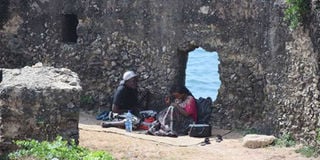Faithful turn relic of Portuguese rule into pilgrimage site

Christians pray at the Gorilla ruins, a historical site near Mama Ngina Drive in Mombasa County, which people of different denominations visit for spiritual nourishment. PHOTO | WACHIRA MWANGI | NATION MEDIA GROUP
What you need to know:
- The cliff overlooks the popular Mama Ngina Drive and has a scenic view of the sea, stretching inland to the Likoni channel.
- It is not uncommon to see worshippers walking around speaking in tongues, preaching, reading the Bible, praying and meditating on scripture.
- One thing that stands out is that the pilgrims mingle freely and pray together, regardless of denomination, perhaps bound together by the prayer burdens they each carry.
- The ruins are believed to be part of Fort St Joseph, built by the Portuguese during their occupancy of the Coast.
Victoria Njeri has been praying from the top of a cliff by the sea in Mombasa for days. The prayer sessions are daylong but she also stays up most of the night to continue with the supplications. With other pilgrims, they devote themselves to praying and fasting, which entails going without food for days.
The cliff overlooks the popular Mama Ngina Drive and has a scenic view of the sea, stretching inland to the Likoni channel.
It is at the ruins located in the cliff that pilgrims from all walks of life gather to “seek the face of God” in prayers. It is not uncommon to see worshippers walking around speaking in tongues, preaching, reading the Bible, praying and meditating on scripture.
Ms Njeri lives in Nairobi but has visited the grounds in the past. She describes her trips to the prayer site as unforgettable spiritual experiences.
SPIRITUAL GROWTH
“I started coming here in 2010. I had moved to South Coast. Although I have relocated to Nairobi, I came back to see where my spiritual growth started. In Nairobi I go to Ngong hills. I was here from Monday night and I will be here up to Wednesday before I travel back to Nairobi,” she says.
One thing that stands out is that the pilgrims mingle freely and pray together, regardless of denominations, perhaps bound together by the prayer burdens they each carry.
Most women wear simple long dresses and headscarves. The men too are required to dress modestly. They pray together and share very close living quarters.
Those who spoke to the Nation described the visit as a must-do event that has a powerful spiritual and emotional impact.
TRANSFORMATIONS
According to Pastor Simon Somoine, the area has seen many transformations, but the experience of fasting and praying in it, for devoted Christians, is just as meaningful as it would have been back in the day.
The ruins are believed to be part of Fort St Joseph, built by the Portuguese during their occupancy of the Coast.
This is backed by an inventory report commissioned by the National Museums of Kenya titled Historical Buildings at the Mama Ngina Drive, Mombasa.
PORTUGUESE TIMES
The report carries findings of a survey and mapping of sites at Mombasa’s south area covering the coastline between Likoni and Fort Jesus.
“It was maybe a church during the Portuguese times. People also used it for prayers. There are some writings inscribed on the walls. Some show people have prayed in here. Some date 1970,” says Mr Somoine.
He says people used it as a place of worship.
“People call it Gorilla but the real name is St Joseph. It might have been a church during the times of the Portuguese when they were in Mombasa. After that the government came and took over and it is under the National Museums of Kenya,” he says.
The ruins were left abandoned attracting no visitors but idlers who roamed about.
FOREST
“Before we started praying here it was like a forest. People used to come here and do their own things. When Christians came here, those idlers left. We even started to maintain and take care of some of the buildings,” Mr Somoine says.
Most visitors set out open to the possibility of having their identity and faith challenged.
Some, like Mr Somoine, have left their homes and settled in Mombasa.
“I come from Loitokitok. I have been in Mombasa since 2011. We have people who are big pastors who visit from Nairobi, Zambia and Malindi. They are people who have frequently visited here and grown to be the pastors they are today,” he says.
Whether in a group or not, they welcome all denominations, says Mr Somoine.




